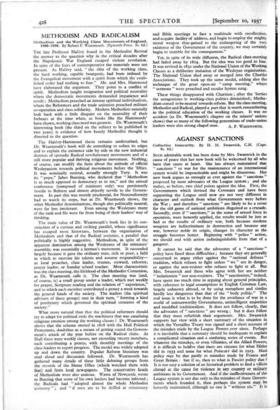METHODISM AND RADICALISM
Methodism and the Working Class Movements of England, 1800-1850. By Robert F. Wearmouth. (Epworth Press. 8s. 6d.) THE late Professor Halevy found in the Methodist Revival the answer to the question why in the critical decades after the Napoleonic War England escaped violent revolution. In spite of the fears of contemporaries the materials were not present. As Halevy said, "the elite of the working class, the hard working, capable bourgeois, had been imbued by the Evangelical movement with a spirit from which the estab- lished order had nothing to fear." Mr. and Mrs. Hammond have elaborated the argument. They point to a conflict of spirit. Methodism taught resignation and political neutrality where the democratic movements demanded impatience and revolt ; Methodism preached an intense spiritual individualism, where the Reformers and the trade unionists preached militant co-operation and class solidarity. Modern Methodists naturally look back with a little disquiet on the neutrality of their forbears at the time when, as books like the Hammonds' have shown, working class need was greatest. Dr. Wearmouth's interesting book (the third on the subject to be published in two years) is evidence of how keenly Methodist thought is directed to the question.
The Halevy-Hammond thesis remains =disturbed, but Dr. Wearmouth's book will do something to soften its edges and to explain the existence side by side in the new industrial districts of sporadic Radical revolutionary movements and of a still more popular and thriving religious movement. Nothing, of course, can modify the facts about the attitude of official Wesleyanism towards political movements before the 'fifties. It was nominally neutral, actually strongly Tory. It was its "pope," Jabez Bunting, who declared that "Methodism is as much opposed to democracy as to sin," and the annual conference (composed of ministers only) was persistently hostile to Reform and almost abjectly servile to the Govern- ment. In part this was merely prudential, for Nonconformity had to watch its steps, but as Dr. Wearmouth shows, the other Methodist 'denominations, though also politically neutral, were far less intolerant. Even among the Wesleyans many of the rank and file were far from being of their leaders' way of thinking.
The main value of Dr. Wearmouth's book lies in its con- struction of a curious and striking parallel, whose significance has escaped most historians, between the organisation of Methodism and that of the Radical societies, a parallel that politically is highly suggestive. Methodism, in spite of the apparent domination among the Wesleyans of the ministers' assembly, was essentially a layman's movement. It succeeded largely because it gave the ordinary man, rich or poor, a field in which to exercise his talents and assume responsibility— as local preacher, class leader, trustee, steward, exhorter, prayer leader, or Sunday school teacher. Most characteristic was the class meeting, the lifeblood of the Methodist Connexion, as Dr. Wearmouth calls it. The class meeting was (and, of course, is) a small group under a Irnder; which met weekly for prayer, Scripture reading and the relation of" experience," and to which each member contributed a penny a week towards the general funds of the society. The leaders (the spiritual advisers of these groups) met in their turn, "forming a kind of presbytery which governed the spiritual concerns of the society."
What more natural than that the political reformers should try to adapt for political ends the machinery that was canalising religious emotion among the working classes ? Dr. Wearmouth shows that the scheme started in i8113 with the Hull Political Protestants, doubtless as a means of getting round the Govern- ment's attack of the year before on the Radical clubs. At Hull there were weekly classes, not exceeding twenty members, each contributing a penny, with Monthly meetings of the class leaders to report progress. The model was widely adopted up and down the country. Popular Reform literature was read aloud and discussion followed. Dr. Wearmouth has gathered many details of these little debating groups from the records of the Home Office (which watched them with fear) and from local newspapers. The conservative heads of Methodism were also anxious. Wawa of Newcastle wrote to Bunting that some of his own leaders had become infected; the Radicals had "adopted almost the whole Methodist economy " ; and "if men are to be drilled at missionary and Bible meetings to face a multitude with recollection, and acquire facility of address, and begin to employ the mighty moral weapon thus gained to the endangering of the very existence of the Government of the country, we may certainly begin to tremble for the consequences."
Yet, in spite of its wide diffusion, the Radical class-meeting had faded away by 1824. But the idea was too good to lose. It was revived in 1831 under the National Union of the Working Classes as a deliberate imitation of the Wesleyan organisation. The National Union died away or merged into the Chartist Associations. They took up the same model, adding also the technique of the great open-air "camp meeting," where "sermons " were preached and secular hymns sung.
These things disappeared with Chartism ; after the 'forties the antagonisms in working-class politics diminished; Metho- dism ceased to be neutral towards reform. But the class meeting, Methodist and Radical, played a part that is win di remembering in the political education of the working classes. It was no accident (as Dr. Wearmouth's chapter on the miners' unions shows) that so many of the following generations of trade-union leaders were also strong chapel men. A. P. WADSWORTH.










































 Previous page
Previous page